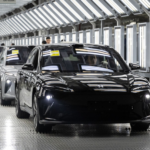Introduction
As Donald Trump returns to the White House in 2025, China’s response has been anything but conciliatory. From economic decoupling to strategic partnerships, Beijing has adopted a bold, defiant stance. With the phrase “We don’t care” trending across Chinese state media, it’s clear that China is forging a future that looks beyond American influence.

1. Strengthening Ties with the Global South
In contrast to Trump’s “America First” policy, China is expanding its diplomatic and economic relationships in Africa, Latin America, and Southeast Asia. Major Belt and Road Initiative (BRI) projects are back in full swing, with new infrastructure deals signed in Brazil, Kenya, and Indonesia.
- Over $100 billion in new BRI financing announced in Q1 2025
- Strategic partnerships with the African Union and ASEAN deepened
2. Accelerating Technological Self-Reliance
After years of U.S. export bans, China has doubled down on domestic semiconductor production, AI development, and space exploration. Government investment in tech startups hit record highs, signaling a long-term decoupling from U.S. tech giants.
- China’s SMIC opens 5nm chip factory without U.S. parts
- Huawei launches AI rival to ChatGPT, focused on Mandarin-speaking markets
3. Redirecting Trade Partnerships
While Trump has reimposed tariffs and trade restrictions, China is expanding trade with the EU, Middle East, and Global South. A landmark trade pact with the Gulf Cooperation Council (GCC) is now in effect, and the yuan is increasingly used in energy deals.
- Yuan accounts for 30% of oil transactions with Saudi Arabia
- China-EU trade volume grows 12% despite transatlantic tensions
4. Asserting Military and Maritime Presence
In the South China Sea and Taiwan Strait, China is responding to increased U.S. naval activity with its own military drills. Beijing’s stance is firm: any perceived U.S. provocation will be met with “reciprocal consequences.”
- PLA Navy launches largest-ever joint drill with Russia and Iran
- New base in Cambodia draws international scrutiny
5. Weaponizing Soft Power and Media
State-controlled media outlets like CGTN and Xinhua are launching global campaigns portraying the U.S. as a destabilizing force. Simultaneously, Chinese influencers are gaining traction abroad, subtly promoting Beijing’s worldview to a younger, digital-native audience.
- CGTN debuts TikTok-style platform with 100M users in Asia and Africa
- “We don’t care” slogan spreads across international forums
Conclusion
In 2025, China is no longer reacting to the U.S.—it’s recalibrating the global order on its own terms. From economic independence to geopolitical alliances, China’s defiant message to Trump’s America is clear: the era of Western dominance is no longer guaranteed. As the world watches this power struggle unfold, one thing is certain—the geopolitical balance is shifting fast.
Related Read: How Trump’s 2024 Win Reshaped U.S. Foreign Policy









